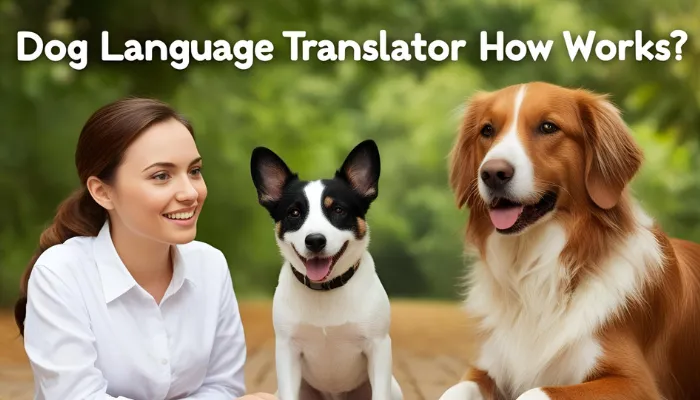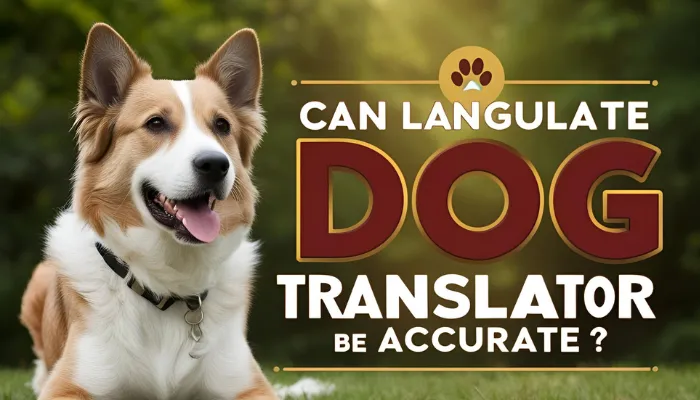The dog language translator apps use AI to decode barking, whining, and body movements to reveal what a dog feels. Although these tools can be useful, there is disagreement about how accurate they are. Users often look for a Dog language translator online free so they can try some features before paying for premium versions.
These tools range from AI analysis to pressing buttons, and all of them seek to connect people with their pets. The DogWhistles translator apps provide entertainment with an element of practicality, although real comprehension stems from watching how dogs behave naturally.

Dog Language Translator: How It Works?
Dog language translator apps use AI to interpret barks and body language. These tools analyze vocal patterns and gestures to predict emotions. Free versions let users explore basic features before upgrading.
Modern dog language translator apps and devices use AI, sound analysis, and behavioral data to interpret a dog’s vocalizations and gestures. They work based on:
- Sound Frequency Analysis: Detecting pitch variations in barking.
- Machine Learning: Comparing sounds with an existing database of dog vocalizations.
- Body Language Recognition: Identifying tail wagging, ear positioning, and posture.
- AI Predictions: Using past data to determine possible meanings.
Key Features of Dog Translators
Dog language translator tools use AI to analyze barks, behaviors, and emotions.
| Feature | Description |
|---|---|
| Voice Recognition | Detects barking, whining, and growling patterns |
| AI Learning | Uses data to improve accuracy over time |
| Behavior Mapping | Correlates sounds with actions |
| Text/Audio Output | Converts dog sounds into text or human speech |
Many users look for a dog language translator online free to test these tools before committing to premium versions.
Dog language translator apps use AI to decode barks and gestures. Free versions help users test basic features before upgrading. Understanding your dog’s sounds strengthens communication.
Popular Dog Language Translators
Dog language translator apps claim to decode barks and emotions using AI. Some focus on fun, while others aim for deeper insights. Exploring different options helps owners understand their pets better.
Several apps and gadgets claim to translate dog language. Here are some of the most well-known ones:
1. BowLingual
BowLingual is an AI-powered dog language translator that analyzes vocalizations to detect emotions.
- Developed by Japanese researchers
- Uses AI and a database of dog sounds
- Categorizes emotions such as happiness, sadness, and aggression
This tool helps interpret your dog’s feelings, but its accuracy has limitations.
2. DogHunch
DogHunch uses AI to analyze barking patterns and detect emotional states.
- AI-powered app that analyzes barking patterns
- Provides emotional insights based on frequency and tone
While it offers insights, its accuracy depends on vocal variations.
3. Human-to-Dog Translator (Fun App)
Human to Dog Translator is a fun mobile app that provides humorous interpretations of dog sounds.
- Available on mobile stores
- Mostly for entertainment, with humorous translations
Designed for entertainment, it offers playful translations rather than scientific accuracy.
4. FluentPet
FluentPet enables dogs to communicate by pressing buttons with recorded words.
- Uses buttons to help dogs communicate with humans
- Dogs press buttons with recorded words
While these apps offer some insight, they are not perfect. Users often turn to dog language translator online free options to experiment before deciding on a purchase.
Dog language translator apps give a glimpse into canine communication. Free options let users explore features before investing in premium tools. AI-driven analysis helps decode barking patterns and emotions. Understanding your dog’s signals strengthens the bond between pets and owners.

Can a Dog Language Translator Be Accurate?
Dog language translator technology has improved, but accuracy remains a challenge. AI can detect emotions, yet vocal variations make precise translation difficult. These tools offer insights, but true understanding comes from observing your dog.
While AI and data analysis have improved, dog language translators still have limitations. Here’s what studies suggest:
Pros:
Dog language translator tools offer several benefits for understanding canine emotions.
- Can detect emotional states like excitement or distress
- AI improves accuracy over time
- Helps understand basic cues
- Can strengthen human-dog bonds
While helpful, their effectiveness depends on AI accuracy and vocal variations.
Cons:
Dog language translators face challenges due to vocal variability and limited sound databases.
- Limited database for sound analysis
- Variability in dog vocalizations makes accuracy inconsistent
- No scientific consensus on precise translation
Many dog language translator online free tools have fun features but lack scientific validation.
Dog language translator apps offer insights but are not fully precise. Free versions provide a fun way to explore canine communication. AI enhances accuracy, yet vocal variations remain a challenge. Understanding your dog’s emotions matters more than exact translations.
Alternative Ways to Understand Your Dog’s Language
Dog language translator tools can be helpful, but real understanding comes from observation. Bark types, body language, and eye contact reveal a dog’s true emotions. Learning these natural signals strengthens the human-dog bond.
Instead of relying solely on an app, dog owners should learn natural communication cues. Here’s a breakdown:
1. Understanding Bark Types
Different bark types reveal your dog’s emotions, from excitement to discomfort.
- Rapid Barking: Alert or excitement
- Low Growl: Warning or discomfort
- Whining: Anxiety or need for attention
Paying attention to these barks helps you better understand your dog’s needs and feelings.
2. Decoding Body Language
Your dog’s body language speaks volumes about their emotions and intentions.
- Tail Wagging: Can indicate happiness or nervousness
- Ears Pulled Back: Sign of fear or submission
- Paw Raising: Asking for attention
By observing these signs, you can strengthen your bond and respond to their needs more effectively.
3. Observing Eye Contact
Eye contact with your dog can reveal important emotional cues and intentions.
- Soft Gaze: Affection and trust
- Staring: Challenge or dominance
A dog language translator can be fun, but real understanding comes from observing body language and vocal patterns.
Dog language translator apps help, but real insight comes from observation. Watching tail movements, ear positions, and vocal cues builds deeper understanding. Learning natural signals strengthens the bond between dogs and owners. True communication goes beyond translations.

What Scientists Say About Dog Translators?
Dog language translator research continues to evolve with AI advancements. Studies show dogs rely more on body language than vocal sounds. Scientists view these tools as fun aids, not perfect solutions.
Research on canine communication is ongoing, but studies highlight key findings:
- Dogs use over 20 different types of barks for various emotions.
- Dogs communicate more through body language than vocalization.
- AI can predict some emotional states but not detailed thoughts.
Researchers recommend using dog language translators as supplementary tools rather than relying on them entirely.
Are Dog Language Translator Online Free Options Worth Trying?
Dog language translator online free options let users explore canine communication. While most free apps are for fun, they can still offer basic insights. Testing different tools helps gauge their usefulness.
For those curious, trying a dog language translator online free is a great way to experiment. However, keep these points in mind:
🔹 Most free apps are for fun and not scientifically validated.
🔹 Some paid versions offer better AI learning capabilities.
🔹 Free versions can still provide basic emotional insights.
Trying different dog translator apps and observing your dog’s reactions can help determine if these tools work for you.
Future of Dog Translators – What’s Next?
Dog language translator technology keeps advancing with AI-driven improvements. Future models may offer real-time translations and enhanced accuracy. Wearable devices could bridge the gap between pets and owners.
As AI evolves, future dog language translator technologies may:
- Improve voice pattern recognition
- Develop real-time translation devices
- Use wearable tech for more accurate readings
While current models have limitations, future advancements may bring dog translators closer to reality.
Dog Language Translator FAQs
Wondering how dog language translator apps work? Check out these FAQs for quick answers about decoding your dog’s emotions and vocalizations.
1. Can dog language translator apps be relied upon for accuracy?
Apps that claim to translte for dogs can give one an understanding of the nuances, but accuracy is not their forte because of issues with pitch variation.
2. Are there free versions of dog language translator apps?
Sure, a lot of dog language translator apps have free versions that allow you to check out certain features before purchasing.
3. What is the working principle of dog language translators?
Translators of this type analyze barks, whimpers, and gestures through AI, acoustics, and motion imaging.
4. What is the best dog language translator app in your opinion?
Some of the more popular options are BowLingual, DogHunch, FluentPet, and Human-to-Dog Translator.
5. What do you think is the most effective way of getting to know your dog?
Knowing how your dog behaves naturally is more insightful than any translation device, whether in speech or sign.
While these tools offer fun insights, true communication comes from observing your dog. Explore and enjoy learning more about your furry friend’s signals!
Conclusion
A dog language translator might be a novel piece of technology, but it certainly has its flaws. Translations made by AI-driven applications and devices provide some understanding into a dog’s feelings but do not facilitate conversations yet. If you’re on the lookout for a free dog language translator, there are several applications which let you play with your pet in engaging ways.
The most effective approach to resonate with a dog is by focusing on watching, teaching, and sharing time with them. A translator can provide direction, but at the end of the day, your dog’s affection and devotion speaks louder than any application.
